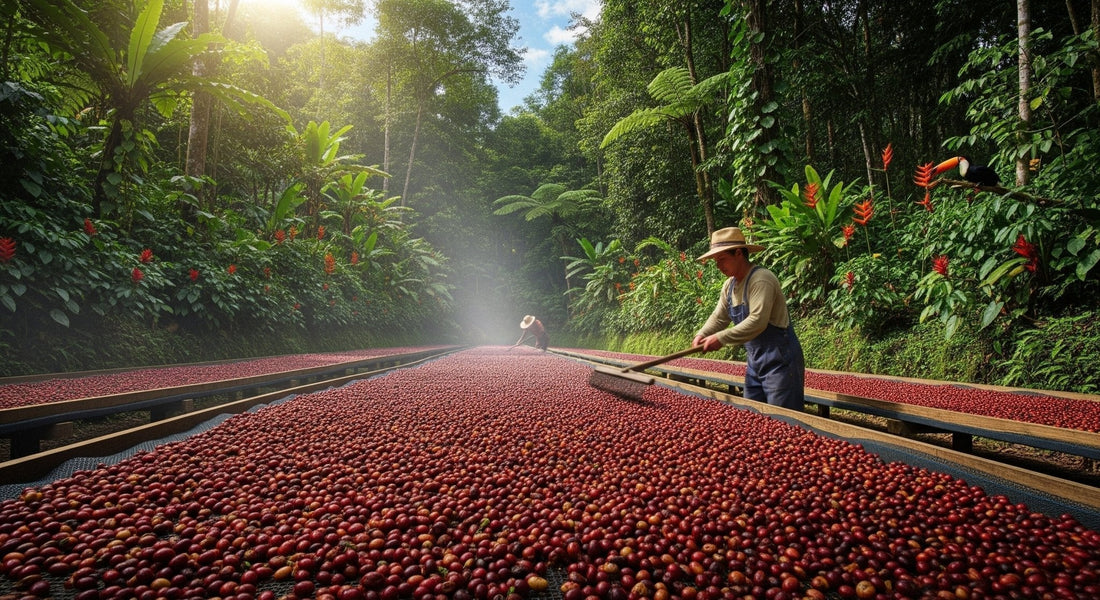
Natural (Dry) Process Coffee: Big Sweetness, Bold Fruit
Natural process coffee—the oldest method—dries the whole cherry around the seed. Extended fruit contact drives specialty coffee taste toward ripe fruit, jammy sweetness, and heavy body when executed with precision.
Want to know when a natural might outshine a blend—or vice versa? Read Single Origin vs. Blends for context on how processing complements sourcing decisions.
Origins & Regional Context
Natural processing likely originated in Ethiopia and Yemen, where arid climates made sun-drying efficient. Today it thrives in Brazil (patio/mechanical drying), Ethiopia (raised beds), and parts of Central America with careful moisture management. The common thread: enough sun and airflow to dry cherries evenly without mold.
The Step-by-Step Workflow (Farm Level)
- Selective picking & sorting: Ripe cherry only; floaters removed.
- Whole-cherry drying: Single layers on raised beds/patios, turned frequently to prevent hotspots. Shade netting modulates heat.
- Drying curve: Typically 15–25 days (climate dependent) to ~10.5–11.5% moisture. Slow, even drying preserves fruit and reduces phenolic harshness.
- Conditioning: Rest in well-ventilated storage to equalize internal moisture.
- Hulling & grading: Dried fruit husk is mechanically removed; beans are screened, density-sorted, and defect-sorted.
Why Naturals Taste So Different
Enzymatic activity and microbial fermentation in the intact fruit elevate sugar migration and ester formation, while prolonged drying amplifies berry-like volatiles. Expect blueberry, strawberry, tropicals, red grape, and cocoa, typically with lower perceived acidity and a syrupy or velvety body.
Quality Risks & How Producers Mitigate Them
- Over-fermentation: Winey/boozy or vinegar notes. Managed with thin layers, frequent turning, and cool-night rest.
- Mold & phenolics: From rewetting or stacked cherries; prevented with raised beds, airflow, and tarping during rain.
- Quakers (immature beans): Minimized through rigorous picking and color sorting.
Sustainability & Labor
Naturals use minimal water but require vigilant labor for turning and sorting. As climate variability increases, shade infrastructure and covered drying help keep quality high without excess energy use.
Brewing Recommendations (Home)
- French Press: 1:13.5, coarse grind, 93–96°C; 4–5 min steep. Expect plush texture and dessert-like sweetness.
- Pour-over: 1:16, medium grind, 92–94°C; manage bloom to avoid channeling from darker, oilier beans.
- Espresso: 1:2, 92–94°C; naturals pull syrupy shots with explosive fruit. Adjust pre-infusion to stabilize flow.
- Cold Brew: 1:8 concentrate, 12–16 hours at cool room temp; diluting to taste preserves chocolate-berry sweetness.
Origin Examples & Profiles
- Ethiopia (Natural): Blueberry, florals, candied citrus; silky body.
- Brazil (Natural/Pulped Natural): Milk chocolate, hazelnut, dried fruit; smooth, low acidity.
- El Salvador / Nicaragua: Red fruit, panela, cocoa; balanced, crowd-pleasing naturals.
Misconceptions to Drop
- “Naturals are always funky” – Top-tier naturals are clean and articulate; “funk” comes from poor drying or defects.
- “Naturals can’t be bright” – High-altitude, dense naturals can show lively acidity alongside big sweetness.
Shop Steel Oak Coffees
Craving bold, fruit-forward cups? Explore our limited Single Origin releases, or set and forget with a Steel Oak Subscription. Then compare your favorite natural against our Washed and Honey guides, and explore how they fit into Single Origin vs. Blends.
Further reading: Single Origin vs. Blends • Coffee Taster’s Flavor Wheel • What “Specialty Grade” Actually Means
